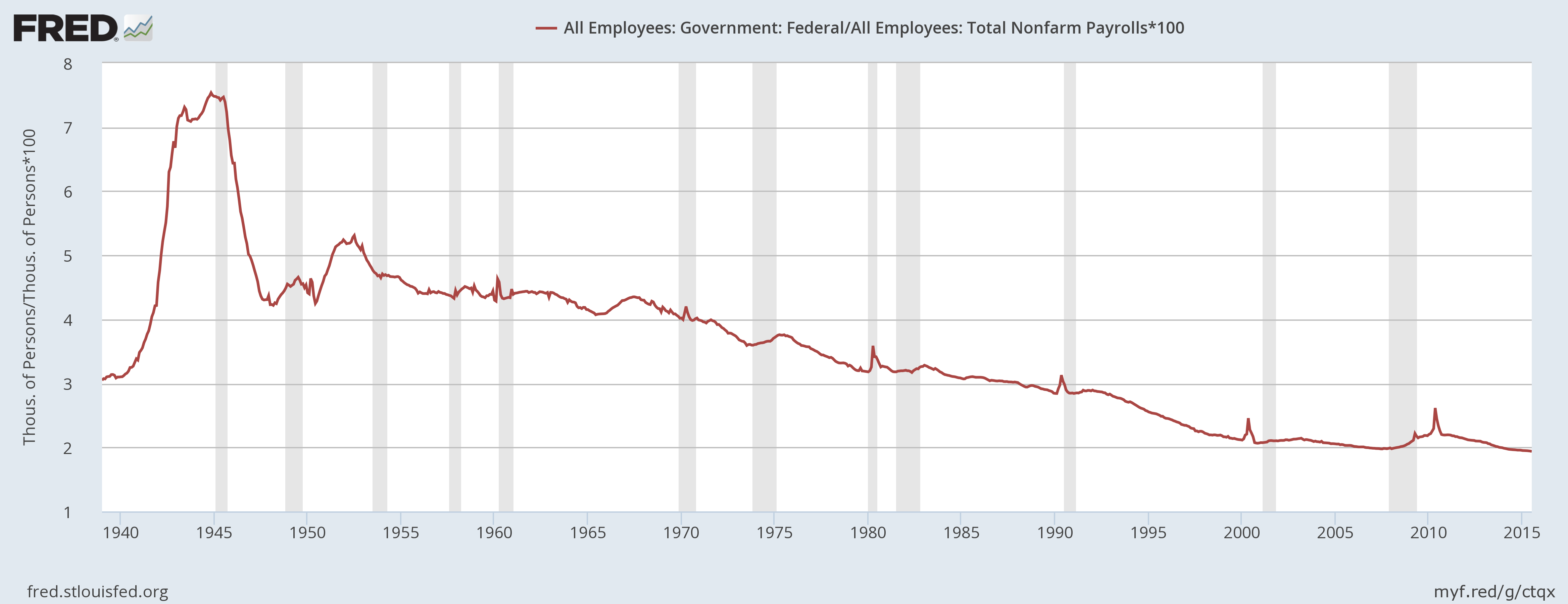As DavePhD pointed out, the executive memorandum only applied to the executive branch. The Office of Management and Budget reports historical data since 1981 for "Total Executive Branch Civilian Full-Time Equivalent (FTE) Employees (excluding Postal Service)" in this file. I included the data at the bottom of this answer. For convenience, here is a plot of all values since 1981, made by me:

Also from the same data, we find that the agency that has grown the most (in %) over the last eight years is the Department of Veterans Affairs. The agencies that have grown in the last eight years are: Department of Defense (added 30k civilian employees, or 4% of its current number), HHS, Education, Social Security (added 15k, 10% of current), Homeland Security (18k, 10% of current), Justice (11k, 9% of current), Veterans (95k, 26% of current), and Other (2k, 1% of current). Some departments have become smaller over the last eight years: Agriculture (-3k, -3% of current), Interior (-2k, -3% of current), Treasury (-6k, -6% of current). Transportation has not changed.
In graphical form:

Since Sean Spicer did not specifically say he was referring to the executive branch when he claimed "dramatic expansion of the federal workforce", we might also consider total federal workforce. Here is "All Employees: Government: Federal" from the Bureau of Labor Statistic's Current Employment Statistics via FRED, in Thousands of Persons, Seasonally Adjusted (note: vertical axis begins at 800, horizontal axis begins around 1940):

Note that the federal government "experiences a spike in employment every 10 years for the collection of the decennial census" (as per BLS).
We can also look at the share of government employment in total employment, as suggested here, to better understand government employment in the context of growing population. Here is 100*Federal Government Employees/All Non-Farm Employees (note: vertical axis range is 1 to 6):

Note that in the BLS CES statistics, "Government employment covers only civilian employees; it excludes uniformed members of the armed services." (See their FAQ.)
"Total Executive Branch Civilian Full-Time Equivalent (FTE) Employees (excluding Postal Service)" 1981-2017, in thousands. 2016 and 2017 numbers are estimates.
Year Total DoD Civilian Agencies
1981 2,109 947 1,162
1982 2,074 978 1,096
1983 2,074 983 1,091
1984 2,083 999 1,083
1985 2,112 1,029 1,084
1986 2,113 1,041 1,071
1987 2,105 1,032 1,073
1988 2,109 1,007 1,102
1989 2,129 1,023 1,106
1990 2,174 1,006 1,168
1991 2,112 969 1,143
1992 2,169 973 1,196
1993 2,139 932 1,207
1994 2,052 868 1,184
1995 1,970 822 1,148
1996 1,891 779 1,112
1997 1,834 746 1,088
1998 1,790 707 1,082
1999 1,778 681 1,097
2000 1,814 660 1,153
2001 1,737 650 1,087
2002 1,756 650 1,106
2003 1,826 649 1,177
2004 1,821 650 1,171
2005 1,830 653 1,177
2006 1,833 662 1,171
2007 1,832 659 1,173
2008 1,875 671 1,204
2009 1,978 703 1,275
2010 2,128 741 1,386
2011 2,102 771 1,331
2012 2,091 765 1,326
2013 2,058 738 1,320
2014 2,033 724 1,310
2015 2,042 725 1,317
2016 2,106 738 1,368
2017 2,137 733 1,404




